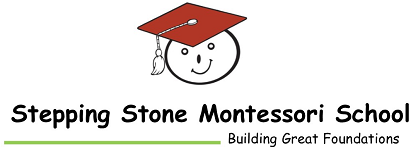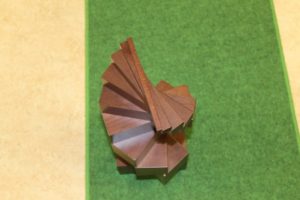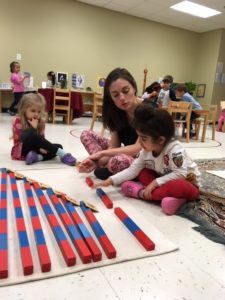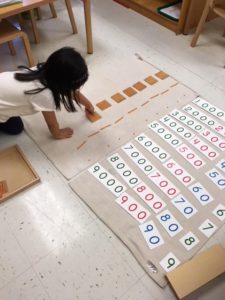Mathematics is a language that children naturally understand at an early age because it involves a sense of order, pattern, and precision, all of which are inherent in the developing child. At an early age, children in the Montessori environment acquire these patterns through sensorial experiences. For example, materials such as the Pink Tower, Red Rods, Broad Stair, etc., allow the child to develop spatial relations and coordinated movement, all of which prepare the child for the mathematical mind. For example, through the use of the Pink Tower and the Broad Stair, the child prepares his mind for exact dimensions. The Pink Tower material consists of cubes that vary in size by one centimeter squared. As the child builds and manipulates the tower, he develops a visual (and muscular) perception of dimension. When working with the Red Rods, the child is indirectly preparing himself for number work with the Number Rods in mathematics. The Number Rods “…provide not only an absolute but also a relative concept of numbers [and] their proportions have already been studied in the sense exercises” (Montessori, p. 264, 1967).
According to Maria Montessori, the child’s “Mathematical Mind” is the impulse to “…produce order out of disorder.” It is the internal desire and ability of the child to create order and precision within his natural environment. The Montessori classroom environment, authentic experiences, and materials allow the child to nurture these delicate concepts. Dr. Montessori quite often used the term “materialized abstraction,” which basically refers to the concrete materials that are specifically designed to help the child develop a better understanding of abstract concepts developed by humans. These materials are found throughout the Sensorial area, such as the Pink Tower, Broad Stair, and Red Rods. For example, young children do not understand the abstract concept of length. To help a child gain an understanding of length, the teacher may guide the child to work with the Red Rods. Through proper use of this material, the child actually “feels” the concept of length by sliding his fingers across each rod and then placing the rods back in the correct order. Thus, the abstract concept becomes a materialized abstraction through the use of the Red Rod material.
Furthermore, Mathematics is a process that occurs naturally in young children. However, so many children and even young adults struggle with mathematics. Many children have difficulty understanding mathematics because they are not given tangible items to work with and manipulate. Their home and school environments may neither be stimulating enough nor offer little to no concrete experiences. Often times, children are first taught mathematics by the introduction of the numerical symbol, rather than by the sensorial approach. To illustrate, many teachers introduce mathematics to a young child by showing them the numbers, 1-10, and stating what the name of each number, rather than focusing on the quantity the symbol represents. Ultimately, without a firm foundation of numerical sense through the use of sensory materials and experiences, the child will have a difficult time constructing his own abstractions, thus struggle with future work in all areas of mathematics.
When presenting the Montessori math materials, there is a general pattern that the directress follows so that the child may build upon those concrete experiences, and then freely begin to build his own abstractions. Essentially, mathematics is the study of various types of patterns. Therefore, it is important that the Montessori materials are organized in a specific pattern for the children to better understand the concepts being presented. The materials are organized into six different groups: The Numbers One to Ten, Continuation of Counting, The Decimal System, The Memory Work, The Passage to Abstraction, and Fractions.
The numbers one through ten are first introduced using the Number Rods. This material helps the child memorize the sequence of the material and introduces the language of the numbers in a concrete form. Next, the Sandpaper Numerals are presented. This material helps the child relate the symbol to the quantity he already knows. It also helps him to make the association between the spoken name and the corresponding symbol. After the child is quite familiar with the quantity and symbol, then the directress may introduce the child to the Number Rods and Number Cards activity. This activity helps the child “link” the symbol and the quantity, as well as develop the memory and sequence of the symbols from 1 to 10. After the child has learned the sequence of the numbers, then he may be introduced to the Spindle Boxes. This lesson is important because it introduces the child to the concept of zero. This activity also introduces the numbers as a group of objects, rather than a solid quantity. After the child has a solid understanding of the concept of zero and numbers as groups or “collections,” then the directress will present the Memory Game of Numbers lesson. This activity may be presented as a “test” to see if the child thoroughly understands numbers one through ten. It is also presented to help strengthen the child’s memory of numbers, hence the title of the activity.
After a child is familiar with numeration to ten, then the teacher may introduce the child to the decimal system using the Golden Bead Material. The Presentation of the Decimal System with Beads is the very first lesson that is presented when introducing the decimal system. The unit bead is presented first, followed by the 10 bead-bar or “ten,” then the 100 square and 1,000 cubes or “1,000.” This activity familiarizes the names of each quantity or “category” and allows the child to see the differences in size between each quantity. After the quantities have been presented, the directress introduces the symbols using the Presentation with Cards activity. This activity helps the child associate the quantity with the symbol, as well as gives the child the first look at “0” as a placeholder. Once the child is quite familiar with the categories and corresponding symbols, then the directress will present the Formation of Complex Numbers lesson. Basically, this activity acquaints the child with different categories of numbers and introduces the proper language of the numbers. Once the child is familiar with the different categories, such as ones, tens, hundreds, and thousands using the Golden Bead Material, then the directress may begin introducing the child to static and dynamic addition or the “Bank Game.”
Ultimately, once the child is familiar with counting, has a firm understanding of quantities and their corresponding numerical symbols, and can continually count on his own using the manipulatives provided, then he may be introduced to Memory Work exercises and activities (i.e., Snake Game and Addition Strip Boards with charts 1 & 2), and activities in the “Passage of Abstraction,” (i.e., the Small Bead Frame, Static Addition with the Small Bead Frame, etc.). Dr. Montessori thought that a child may be ready for such exercises once the child could successfully internalize the concept of one through ten. Basically, once the foundational numbers are “secure”, then the child is free to discover other abstractions on his own.



